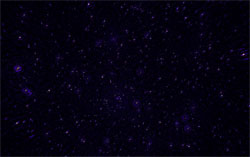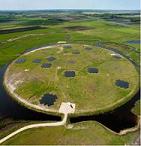Observing the early history of the Universe
LOFAR (Low-Frequency Array) - a pioneering European radio astronomy project for the development of a highly advanced and versatile radio telescope is finally delivering valuable data to set the astronomers in motion. Researchers at the Kapteyn Astronomical Institute, University of Groningen, a key collaborator in the project, have announced that LOFAR has achieved the expected high-performance and sensitivity, making it our most powerful eye to look as far back as 13 billion years into the history of the Universe.
Meet LOFAR

LOFAR is the result of an ambitious initiative aiming at observing the Universe’s distant past. Led by ASTRON (Netherlands Institute for Radio Astronomy), a consortium of European knowledge institutes, universities and industry partners, envisioned, designed and built a low-frequency radio telescope with unprecedented sensitivity. The telescope design is based on the principles of aperture array synthesis, where a large number of small antenna elements are distributed over a certain spatial range to form effectively one large collecting area. Astronomers then use interferometric techniques to combine signals from each antenna and create sharp and deep images of the sky.
Most of the LOFAR array elements (called stations) are spread over an area of 100 square kilometers in the Northeastern part of the Netherlands. Additional eight stations are located in other European countries, the furthermost one being 1500 kilometers away. As a result, LOFAR can resolve very tiny sections of the sky. Moreover, having fast computational resources and efficient software algorithms to manipulate the individual signals from each station, LOFAR can achieve remarkable flexibility, that makes it a powerful tool for observing diverse astronomical phenomena.
Currently, there are six key science projects that will work with observational data from LOFAR, including Epoch of Reionization, solar science and space weather, ultra high energy cosmic rays and more. "LOFAR is a very broad enterprise, which is also a pathfinder to the next most ambitious global effort in radio astronomy - the Square-Kilometer Array (SKA) project [www.skatelescope.org]. In that sense, LOFAR was also set up to explore some of the issues that SKA might face" said Ger de Bruyn - a leading scientist at ASTRON, and one of the leading LOFAR designers.
What are the researchers at the Kapteyn Institute looking for?
One of the key science projects of LOFAR is the Epoch of Reionization or EoR. EoR refers to a very early period in the history of the Universe (around 1 billion years after the Big Bang), when the first luminous sources like stars and galaxies were formed. The radiation from these pioneers ionized the neutral hydrogen that dominated the Universe at that time, hence the distinctive name Epoch of Reionization. This key science project is lead bya group of researchers: Prof. Leon Koopmans and Prof. Saleem Zaroubi at the Kapteyn institute, and Dr. Ger de Bruyn and Dr. Michiel Brentjens at Astron. "The EoR period sets the scene for most of what we currently see around us and that makes it an extremely important time in the history of the Universe. Detecting and decoding signals from the EoR has the highest priority for many new telescopes and scientific teams in both Europe and the USA. It is an incredibly difficult challenge and has never been achieved before," says Prof. Koopmans.
"There is a common sentiment among the international astronomical community that stresses the importance of this particular project calling it transformational science - science that might transform our current views about the Universe," added Dr. Ger de Bruyn
How far has LOFAR gone?

The commissioning data from Lofar that tests the telescope and its performancehave been very encouraging for the scientists at Kapteyn Institute and Astron involved in the EoR key science project."This is very good news for us. The commissioning data indicate that we're ready for scientific observations of the EoR and we plan to start observing this coming winter," said Dr. Ger de Bruyn. A handful of similar efforts for the detection of EoR have been undertaken by other scientific groups around the world, but LOFAR is one step ahead. "The current data and images are already deeper than anyone has gone before. At the moment LOFAR is the largestEoR science project and the most advanced in data-gathering and handling," said Prof. Koopmans.
The road ahead
LOFAR is at the beginning of a path leading to new and exciting science. The telescope is expected tobe operational for the next five years, gathering large volumes of valuable astronomical data. The EoR science group at Kapteyn Institute and Astron is getting ready for intensive data gathering and analysis. " With this data we plan to first set tight limits on the detection of neutral hydrogen, maybe excluding some theoretical models and ultimately, of course, detect the signal itself," said Prof. Koopmans. "I am sure that when we detect the EOR a whole new set of possibilities for excellent science would emerge," added Dr. Ger de Bruyn.
More news
-
15 September 2025
Successful visit to the UG by Rector of Institut Teknologi Bandung
